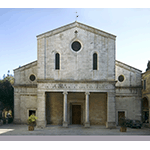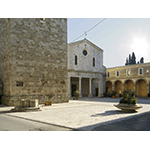Labirinto di Porsenna [Porsenna's Labyrinth]
Known as Porsenna’s Labyrinth because tradition identifies it with the monumental sepulchre described by Roman scholar Pliny the Elder, it is formed by a close network of underground passages which formed the draining system conceived by the Etruscans in the archaic period (6th century B.C.) to exploit the infiltration and aquifer waters. The underground passages vary in size, are dug on various levels, and are connected to the dwellings by means of wells and cisterns. Recently cleared of the detritus that filled them, the tunnels can be visited today, entering from the Cathedral Museum and proceeding to a large cistern of the 1st century B.C. The cistern is formed by a room with a rectangular plan, surmounted by a double vault, where wells were sited for water supply.
****************************
Texts by Graziano Magrini
English translation by Victor Beard
Last update 26/gen/2008





